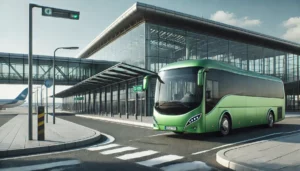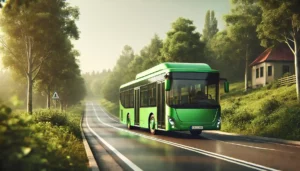The roads and skies of Europe are at a major turning point in recent years. A continentwide shift towards zero-emission means of transportation is being accelerated to tackle the effects of climate change. The goals of which are outlined in policies such as the European Green Deal. Fully electric drivetrains are beginning to gradually displace traditionally used petrol and diesel engines in everything from busy city centers to major airport terminals. At the center of this change is an intriguing and evolving discussion that continues to be an important subject. Will battery-electric transportation or hydrogen fuel cell technology win the majority of hearts?
It is certain that this subject matter is not a typical either/or situation. There are a lot more outside variables and opportunities in the transportation industry that can be measured. Although both technologies are breakthroughs, they each have unique qualities that make them suitable for specific applications. particularly with regard to the massive ecosystem that is modern transportation. Making smart choices and creating a genuinely sustainable future for Europe as a whole depends upon an understanding of these details.
Zero-Emission Ambition
Environmental responsibility isn’t the only reason for the push toward electrification. The goal is to raise every individual’s standard of living while upholding financial wellness on all fronts. Clean public transportation is becoming not only desirable but also necessary as European cities increasingly implement Low Emission Zones and Ultra Low Emission Zones. Our public bus networks are not the only thing being targeted. It continues by covering the crucial and specialized field of airport ground handling. There is growing pressure on airports, which are frequently seen as major carbon emitters, to decarbonize every aspect of their operations. The fleets of apron buses that transport the crew and passengers to and from the aircraft are part of these operations.

Battery-electric and hydrogen technologies both promise zero tailpipe emissions, but they do so in very different approaches. Like a supersized smartphone, automobiles powered by batteries store energy in large battery packs that power the motor. Conversely, hydrogen and oxygen are combined in a fuel cell to create electricity onboard, with water vapor being the only byproduct.
Hydrogen Fuel Cell Buses: The Long-Haul Contender
The potential of hydrogen fuel cells to provide quick refueling times and a longer range, similar to the convenience associated with traditional fossil fuel buses, often grabs headlines for operators looking towards a cleaner option. This makes it a more desirable choice for a variety of demanding uses, like intercity rail, heavy-duty trucks, and long-distance coaches. Hydrogen serves as an appealing option for these markets, where it may not be possible to stop for some time to recharge a battery.
With plans to build refueling networks along important transportation routes, Europe is seeing an increase in investment in hydrogen infrastructure for the potential new hydrogen fuel cell buses. Proponents point out that hydrogen, especially “green hydrogen” generated from renewable resources, is a sustainable energy source for the future that can decarbonize industries that can be difficult to electrify using conventional batteries.
Battery-Electric: Efficiency and Proven Performance
Battery-electric technology has consolidated its reputation as the top option for urban and intra-city transportation, while hydrogen finds a place in the long-haul market. It has numerous benefits:
Improved Energy Efficiency: Compared with hydrogen fuel cell systems, battery-electric drivetrains have a significantly greater energy efficiency. The process of generating, compressing, transporting, and then converting hydrogen back into electricity result in substantial energy losses. Battery-electric vehicles have significantly greater “well-to-wheel” efficiency given that they do not require many of these conversion steps. Lower energy use and operating expenses are the direct results of this.
Maturity and Simplicity: With remarkable range and quick charging times, battery technology has advanced quickly. Because the drivetrain is less complicated and has fewer moving parts than a fuel cell system, it requires less maintenance and is more reliable, two characteristics that are essential for any commercial fleet operator.
Scalable Infrastructure: Electric charging infrastructure is much more flexible and scalable than hydrogen, which requires costly and specialized refueling stations. Chargers can be placed at depots, along routes, or at particular passenger gates or layover locations, which works especially well for buses with airport aprons.

DINOBUS: The Perfect Fit
DINOBUS comes into play here. Battery-electric technology is not only available but, in many respects, the best option for the particular and demanding environment of an airport apron. Airport apron buses travel set, dependable routes in limited space. Their duty cycles are optimal for opportunity charging because they include regular stops and starts, comparatively slow speeds, and planned downtime. In order to ensure continuous operation throughout the day, a DINOBUS electric apron bus, such as our DinoRex or DinoVeloci models, can be quickly charged at a central depot or at a gate during passenger boarding and deboarding.
In brief, an apron bus does not require “long-haul” or “immediate, five-minute refueling,” which tend to be correlated with hydrogen. Efficiency, low operating costs, low maintenance, and reliable, tested technology have been given preference instead. These are exactly what DINOBUS’s battery-electric solutions are recognized for.
Our buses, which have already been effectively installed at key European airports like those in Naples, Rome, Vilnius, and Warsaw, show the practicality and perks of battery-electric power for this particular use case. They provide a large passenger capacity, zero local emissions, and significant noise pollution reductions, making the airport environment healthier and more comfortable for both employees and travelers.
A Future of Coexistence
The goal of the zero-emission race is not to entirely substitute one technology with another. Rather, it’s about taking advantage of every one of their distinct strengths and deploying them intelligently. Without a doubt, hydrogen will be essential to the decarbonization of heavy, long-distance transportation. However, battery-electric vehicles are the most practical, affordable, and accessible option for the particular but crucial field of airport apron operations and a large portion of urban public transportation.
This approach to decarbonization is demonstrated by our team’s dedication to battery-electric technology for airport apron bus solutions. We are doing more than just supplying buses by offering a dependable, effective, and tested zero-emission solution. At our core, we are aiming to support airports throughout the world to make a firm move toward a more sustainable, greener, and quieter future. The race is on, and with a thoughtful application of clean technology, Europe’s future looks bright.